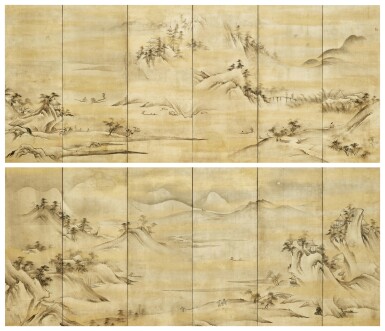
Soga Chokuan (active circa 1596-1615), Eight Views of the Xiao and Xiang Rivers (Shosho hakkei), Momoyama period, late 16th - early 17th century | 曽我直庵 瀟湘八景図屏風 桃山時代 16世紀後半〜17世紀初頭
Session begins in
November 22, 06:00 AM GMT
Estimate
600,000 - 800,000 HKD
Lot Details
Description
pair of six-panel folding screens: ink and gold pigment on paper, sealed Taira Chokuan, silk brocade border, black lacquer mount, engraved copper-gilt fittings
each 137.5 x 57.8 cm. (when folded)
each 137.5 x 324 cm. (when unfolded)
Christie’s New York, Japanese and Korean Art, 16 September, 2003, Lot 114.
Hiroshi Mizuo, "Landscape Screens by Soga Chokuan" in Kokka [Flower of the Nation], vol. 937, Tokyo, 1971.
Takeda Tsuneo, Suiboku bijutsu taikei [Compendium of ink painting], vol. 9: Tohaku and Yusho, Tokyo, 1974, no. 82.
Kobayashi Tadashi ed., Masterpieces of the Okada Museum of Art, vol. 1, Tokyo, 2019, no. 86.
A rare landscape work by Chokuan. Little is known of the artist’s life; the only dated work extant is a votive horse panel (ema) in the collection of the Kitano Tenmangu Shrine in Kyoto inscribed with a Keicho 15 (1610) era date. Active in Osaka, Kyoto, and Nara, Chokuan was primarily known for bird-and-flower paintings (kachoga). Until the discovery of this screen, his landscape work in a large format was virtually unknown.
The screen depicts the traditional Chinese subject of the Eight Views of the Xiao and Xiang Rivers (Shosho hakkei). On the right screen: Mountain Village in Clearing Mist (Sanshi seiran), Returning Sails off Distant Shores (Enpo kihan), Evening Bell from a Mist-Shrouded Temple (Enji bansho), and Sunset Glow over a Fishing Village (Gyoson sekisho); and, on the the left screen: Autumn Moon over Lake Dongting (Dotei shugetsu), Geese Alighting on a Sandy Shore (Heisa rakugan), Evening Snow Blending River and Sky (Koten bosetsu), and Night Rain over Xiao-Xiang (Shosho yau).
The Eight Views motif originated in China during the Northern Song dynasty (960-1127) with the artist Song Di (c. 1015 - c.1080) and arrived in Japan by the late Heian period (794-1185). By the Momoyama period (1573-1615), artists like Chokuan adapted the theme into large-scale folding screens, interweaving Japanese seasonal landscapes and decorative painting techniques, such as the use of trailing mists of gold pigment. This painting employs the gentle brushwork and subtle ink tonalities of Soami (d. 1525), an official painter in service to the Ashikaga family.1
1. Kobayashi Tadashi et. al., Masterpieces of the Okada Museum of Art, vol. 1, Tokyo, 2019, p. 116.
來源
紐約佳士得2003年9月16日,編號114
出版
水尾比呂志,《曽我直庵筆 山水図屏風》,《國華》,卷937,東京,1971年
武田恒夫,《水墨美術大系》,卷9:等伯.友松,東京,1974年,編號82
小林忠編,《岡田美術館名品撰》,卷1,東京,2019年,頁116,編號86
此作為曽我直庵極罕見的山水作品。畫家生平記載甚少,現存唯一紀年作品為京都北野天滿宮所藏「繪馬板」,其上題有慶長十五年(1610)年款。直庵活躍於大阪、京都與奈良地區,原以花鳥畫聞名。在此屏風發現之前,其大型山水作品幾乎不為世人所知。
屏風繪製中國傳統主題《瀟湘八景》。右屏繪有:山市晴嵐、遠浦歸帆、煙寺晚鐘與漁村夕照;左屏則為:洞庭秋月、平沙落雁、江天暮雪及瀟湘夜雨。
「八景」母題源於中國北宋宋迪之《瀟湘八景》,於平安時代末期(794-1185年)傳入日本。至桃山時代(1573-1615年),如直庵等畫家將此主題轉化為大型屏風創作,融合日本四季景致與金雲霞彩等裝飾技法。此作承襲足利家御用畫師相阿彌(卒於1525年)之筆墨意境,展現柔和筆觸與微妙墨韻。1
1. 小林忠等,《岡田美術館名品撰》,卷1,,東京,2019年,頁116。
You May Also Like










